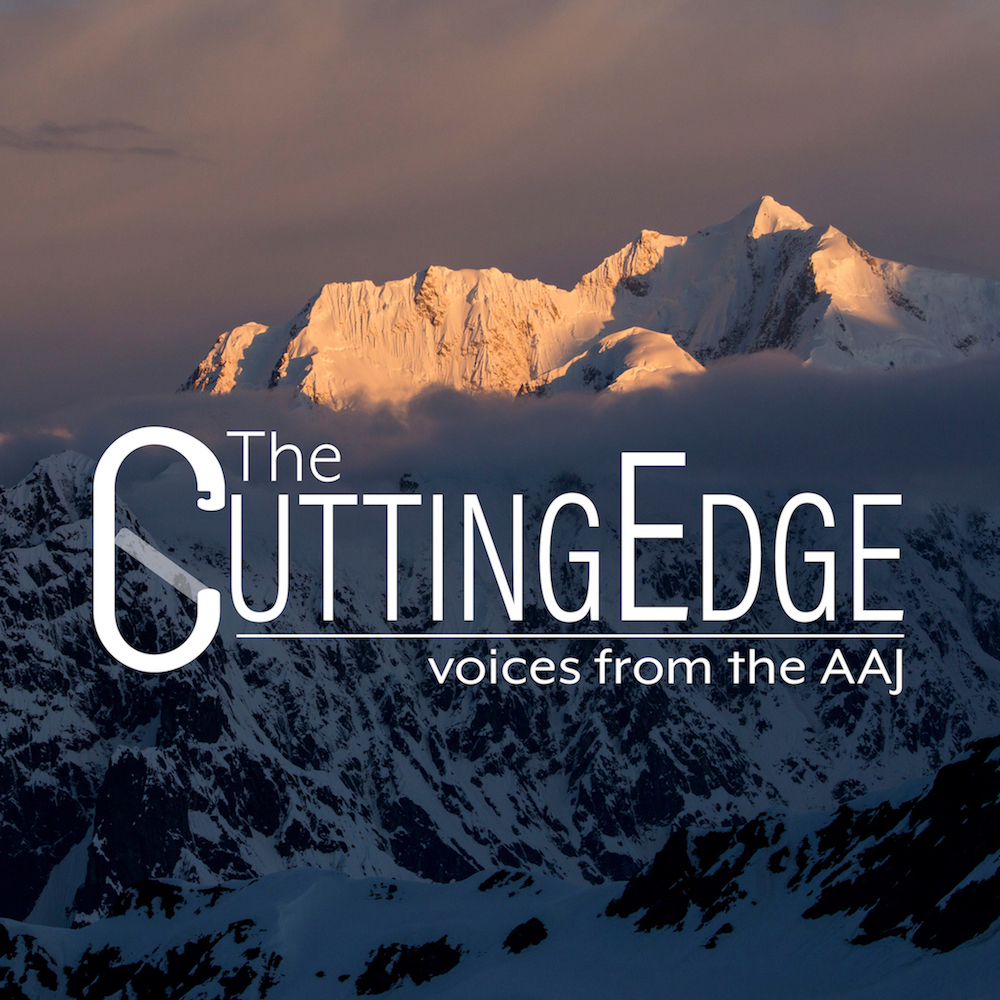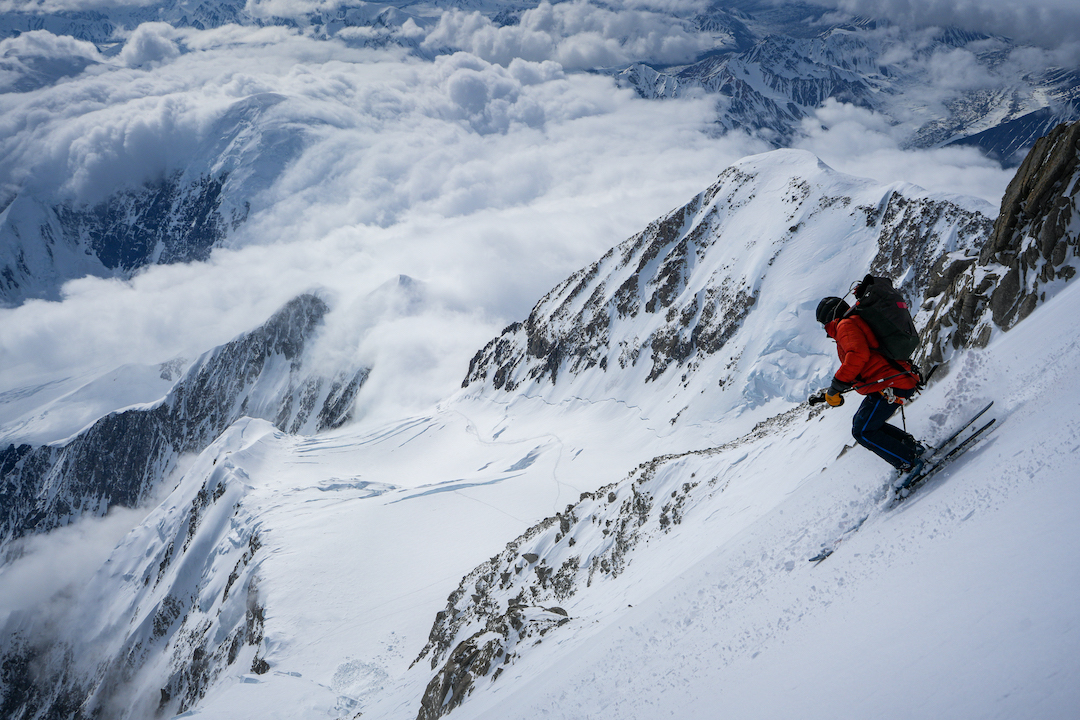Denali, Upper Southwest Face, Ski Descent
Alaska, Alaska Range, Central Alaska Range

I’m not sure why, but I don't like the smell of airports. And yet the smell of duty-free is always synonymous with great adventures to come. So I rejoiced when that familiar scent hit my nose while passing through the Anchorage airport, the gateway to Boris Langenstein and my expedition to Alaska in May.
Soon we were in a mini-bus bound for Talkeetna. As our shuttle driver Gary said, “a lot of land, not a lot of people.” Boris looked out on the wild landscape, hoping to see a bear.
The question of the weather was top of mind. All our friends who go to Alaska come back and say, “It’s freezing, and when I went there it didn’t stop snowing!” We had little time for this trip, and luck would have to be on our side if we wanted to succeed in doing anything.
Our main objective was to ski the Cassin Ridge of Denali (6,190m). The aesthetics of this famous ridge impress with its magnitude and a beautiful, direct line. In order to ski the entire ridge, it would take exceptional snow conditions, all the tricks to avoid the two rock bands, and good conditions in the Japanese Couloir. I had some doubts about the feasibility of the project before leaving, but upon arriving it was clear that it would not be for this time. It was hot, dry and the weather didn’t match with the reports we had received.

With that plan set aside, we were forced to imagine something else. The job was already half done, because we had discussed the option of escaping the Cassin Ridge before the top of the Japanese Couloir. As we climbed from base camp to Camp 1 on the Kahiltna Glacier, we scanned for weaknesses and the line became obvious: It was to climber’s left of the Cassin. It crossed the entire southwest face above a serac to reach the West Rib. From there, we could continue down the West Rib, exiting via the Chicken Couloir, ski out the Northeast Fork of the Kahiltna, and boom! It would be nearly 4,000m of skiing.
On May 21 we began our ascent. I was attached to a sled whose weight I couldn’t comprehend, and I had the feeling that it would play a dirty trick on me. Above Camp 2, I imagined the ridiculous scene of a sled barreling down for a strike into the middle of the tents. Boris had the same vision as me, because I soon saw him come running to help me pull our giant load up the hill.
We chose to go up to 14k camp and to stay there for a few days to acclimatize. This part of our expeditions remains an inexact science and depends on details beyond our control. The heart rate must calm down, the nights must be good, breathing must no longer be torture.
On May 25, I walked onto the Football Field, the big flat before the summit of Denali, and I was still very far from having reached the holy trinity of acclimatization. I even had to give up my skis to Boris to carry for the last section because I felt like my body was letting me down. But I believe that everything is in the mind, and I pushed on. After reaching the summit, we descended the Orient Express couloir, a great reward after 10 hours of forced march. Even if the legs are screaming at you to stop, the pleasure prevails.
 Now it was time to put in place our strategy to ski the line on the southwest face. Skiing with bivouac equipment requires extra effort, so the solution was as follows: Leave a tent at 14 camp, go down to Ccamp 1 and set up another tent (where we would finish our descent), then climb back to the summit in two days and ski from there.
Now it was time to put in place our strategy to ski the line on the southwest face. Skiing with bivouac equipment requires extra effort, so the solution was as follows: Leave a tent at 14 camp, go down to Ccamp 1 and set up another tent (where we would finish our descent), then climb back to the summit in two days and ski from there.
On May 31, we were on our way to our second summit of Denali. This time I was acclimatized correctly. I arrived at the summit with my skis on my own back, eight hours after leaving 14 camp.
This was the delicate and uncertain moment: We had managed the climb, but the descent was full of doubts. How would the snow be? And how about the long crossing to reach the West Rib?
The entrance to the descent was spectacular. The immensity of the face suddenly opened up underfoot, and we had to remember the key passages that were only obvious from below. What had appeared to be small features of snow were in fact wide corridors, small blocks were massive rocks. Incredible snow greeted us in the first third of the face. We couldn’t believe it—it was almost easy, and we found the correct path. But when it came time to begin the massive traverse, I got the impression that we had been trapped.
The good conditions vanished, and we had to abandon our poles to ski on what resembled a World Cup ski track perched above a serac band. And I am not Marcel Hirscher! Slowly, trying to analyze the snow, we moved forward. Sometimes taking a deep breath while crossing a patch of ice at full speed, sometimes clinging to our ice axes. We roped up and placed protection for 50m to get through one consequential section.
After a kilometer of traversing, the trap was avoided and we had managed to keep our skis on. We had been descending for five hours, and we took a break at the West Rib.
The Chicken Couloir was an amazing way to finish the descent: light snow with healthy grip underneath. What a pleasure it was to be there alongside my friend Boris! This was the skiing we love–technical and without risk of avalanche. One last push and we'd be at the tent, but the Northeast Fork was no small feat—a cracked maze where skis proved to be extremely useful.
 Our descent on Denali was a test of my ability to acclimatize, and once again a great challenge on skis. It was one of the most beautiful descents I have ever done—perhaps the most beautiful, the most engaging. Without a doubt it was the longest that I have been able to ski in a day.
Our descent on Denali was a test of my ability to acclimatize, and once again a great challenge on skis. It was one of the most beautiful descents I have ever done—perhaps the most beautiful, the most engaging. Without a doubt it was the longest that I have been able to ski in a day.
Seventeen days after our departure from Geneva, I once again breathed in that familiar odor that I do not like. But this time, it was the smell of heading home and the prospect of returning to the people we love.
— Tiphaine Duperier, France
Editor’s Note: The upper portion of Duperier and Langenstein’s descent shared terrain with the finishing stretch of the Roberts-McCartney (AAJ 1981) route up Denali’s southwest face, then reversed the long traverse of the Clod Face variation to the West Rib (Derbyshire-Grassman-Jones-McKeith, 1977). It’s not known if the exact line skied by the French had been done before—there are rumors of a similar descent in the early 2000s by skiers who did not wish to publicize their exploits. The complete West Rib route was skied by Adam Fabrikant and Aaron Mainer in 2013.
In 2017, a Japanese expedition skied a line described as the “southwest face,” but their route on the upper mountain actually was a variation to skier’s right of the so-called Orient Express. Nonetheless, this was a fascinating and impressive effort: Takao Araiba, Kyoichi Karino, and Daisuke Sasaki, with support of Kazuya Hiraide (filming) and mountain guide Naoyuki Kato, climbed the Cassin Ridge on Denali in ski boots, carrying skis on their backs, over several days. Upon reaching the summit, they started down their line on the upper face, but Araiba was injured in a fall on an icy patch before reaching the West Rib. After evacuating him to 14 camp, Karino and Sasaki climbed back to the West Rib the next morning, continued down the West Rib, and skied out to the Kahiltna Glacier, completing a remarkable round-trip.




